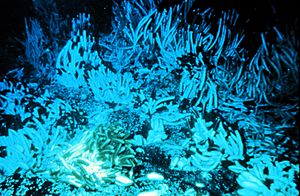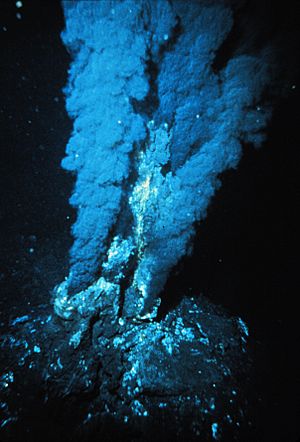Hydrothermal vent facts for kids
A hydrothermal vent is like a hot spring on the ocean floor. It's an opening where heat from deep inside the Earth escapes. Cold seawater goes into cracks in the seabed, gets super hot from the Earth's core, and then shoots back out.
The hottest vents release dark, mineral-rich water and are called black smokers. Some vents release lighter-colored water and are known as white smokers. Heat escapes from underground in many places. On land, these are usually hot springs, geysers, or fumaroles. Many tiny living things, like archaea and bacteria, thrive near these underwater vents. They support amazing creatures such as giant tube worms, clams, shrimp, and many other complex life forms. Scientists even think that the earliest known life forms might have started near these vents.


Contents
Life Around Hydrothermal Vents
Deep-sea creatures live in total darkness, far from sunlight. So, they can't use photosynthesis like plants do. Instead, they rely on special chemicals found in the vent fluids and deposits for their food. Compared to the empty ocean floor around them, hydrothermal vent areas are bursting with life – sometimes 10,000 to 100,000 times more organisms!
How Vent Creatures Get Food
Hydrothermal vent communities can support so much life because many organisms depend on tiny bacteria that use a process called chemosynthesis. These bacteria use chemicals, especially hydrogen sulfide (which is toxic to most other living things), to make their own food. It's like photosynthesis, but with chemicals instead of sunlight.
These chemosynthetic bacteria grow in thick mats, attracting smaller creatures like amphipods and copepods. These tiny animals then graze directly on the bacteria. Larger animals such as snails, shrimp, crabs, giant tube worms, fish, and even octopus form a food chain. They eat the smaller creatures or each other.
The main types of animals found around these seafloor vents include different kinds of worms, snails, and crabs or shrimp. Large bivalves (like clams) and "eyeless" shrimp make up a big part of the non-microbial life.
Amazing Tube Worms
Tube worms are a very important part of the community around a hydrothermal vent. They don't have mouths or stomachs! Instead, they absorb nutrients directly into their bodies. Inside their tissues, there are billions of bacteria – about 285 billion bacteria per ounce of tube worm tissue!
Tube worms have bright red plumes (feather-like parts) that contain hemoglobin. Hemoglobin is the same stuff that makes our blood red and carries oxygen. In tube worms, it also picks up hydrogen sulfide and carries it to the bacteria living inside the worm. In return, the bacteria make carbon compounds, which are food, for the worm.
Other Unique Animals
Other amazing animals live in this extreme environment. One is the snail Crysomallon squamiferum, also known as the scaly-foot gastropod. It has a foot covered in scales made of iron and other materials, making it super tough. Another is the "Pompeii Worm" Alvinella pompejana, which can live in incredibly hot water, up to 80°C (176°F)!
Over 300 new species have been found at hydrothermal vents. Many of these are "sister species," meaning they are closely related to species found in other vent areas far away. Scientists think that long ago, before the North American plate moved over the Mid-Atlantic Ridge, there might have been one large area where these vent creatures lived. When the land moved, it separated these groups, causing them to evolve differently in their new locations. The similar ways different vent species have evolved in separate places strongly supports the idea of natural selection and evolution.
Life Without Sunlight
Even more surprisingly, a type of bacteria that uses light for food (phototrophic bacteria) has been found near a black smoker off the coast of Mexico. This vent is 2,500 meters (about 8,200 feet) deep, where no sunlight can reach. Instead, these bacteria, which are part of the Chlorobiaceae family (green sulfur bacteria), use the faint glow from the hot black smoker for their photosynthesis. This is the first time scientists have found an organism in nature that uses a light source other than the sun for photosynthesis!
Images for kids
-
Many Kiwa crabs and barnacles near East Scotia Ridge vents.
-
Giant tube worms (Riftia pachyptila) gather around vents in the Galapagos Rift.
See also
 In Spanish: Fuente hidrotermal para niños
In Spanish: Fuente hidrotermal para niños







